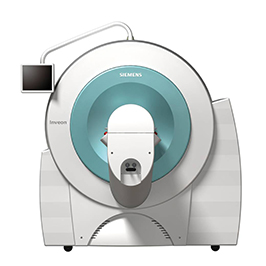X-Ray Computed Tomography (CT)
Benefits of MicroCT Imaging
• Good anatomical imaging of bone, tumor, vascular density (with appropriate contrast agent)
• Quantitative measurements
• High resolution relative to microPET, microSPECT
Ideally Suited For
• Anatomical imaging
• Lung imaging
• Multimodality imaging with microPET or microSPECT to combine functional and anatomical information in a single image
Not Suited For
• Functional imaging
Disadvantages
• Radiation dose to animal
• Poor soft tissue contrast without appropriate contrast agent
X-ray computed tomography (CT) provides high resolution 3-D anatomical imaging. It is particularly useful for imaging bone and fat, but can also provide capabilities for soft-tissue and vascular imaging by the use of suitable contrast agents. Animals can be scanned by PET or SPECT and CT in the same session and the images coregistered to give a single image combining functional PET/SPECT with anatomical CT data.
 Inveon MM CT This module is a powerful tool for x-ray computed tomography of small animals. A variable-focus x-ray source provides a maximum spatial resolution of 50 μm in microfocus mode. In addition, its 165 mm detector allows a large 10 cm x 10 cm field of view (FOV) that can be cropped as desired to match the dimensions of the animal. Both cardiac and respiratory gating are supported, which can improve resolution during in vivo imaging of the heart and lungs, for example. When used for dual-modality imaging with SPECT or PET, the coregistered images display the functional information of SPECT or PET with the anatomical detail of CT in a single image. A CT acquisition can also be used for attenuation correction of the SPECT or PET image acquired during the same imaging session.
Inveon MM CT This module is a powerful tool for x-ray computed tomography of small animals. A variable-focus x-ray source provides a maximum spatial resolution of 50 μm in microfocus mode. In addition, its 165 mm detector allows a large 10 cm x 10 cm field of view (FOV) that can be cropped as desired to match the dimensions of the animal. Both cardiac and respiratory gating are supported, which can improve resolution during in vivo imaging of the heart and lungs, for example. When used for dual-modality imaging with SPECT or PET, the coregistered images display the functional information of SPECT or PET with the anatomical detail of CT in a single image. A CT acquisition can also be used for attenuation correction of the SPECT or PET image acquired during the same imaging session.
